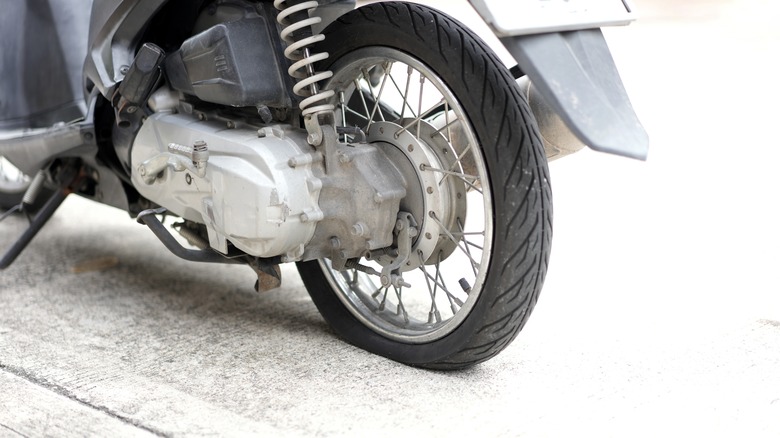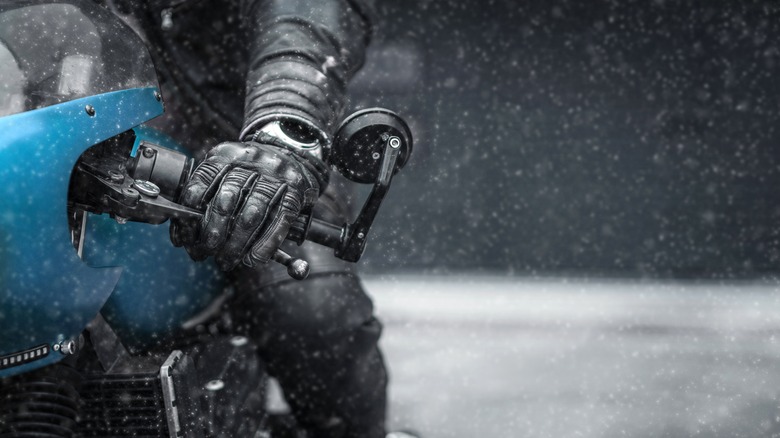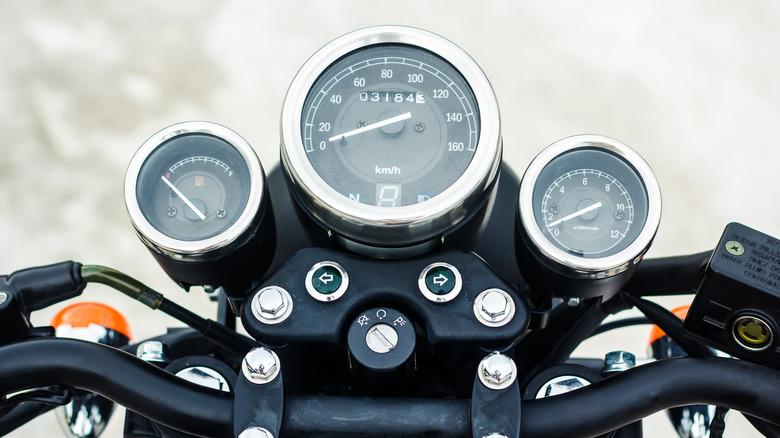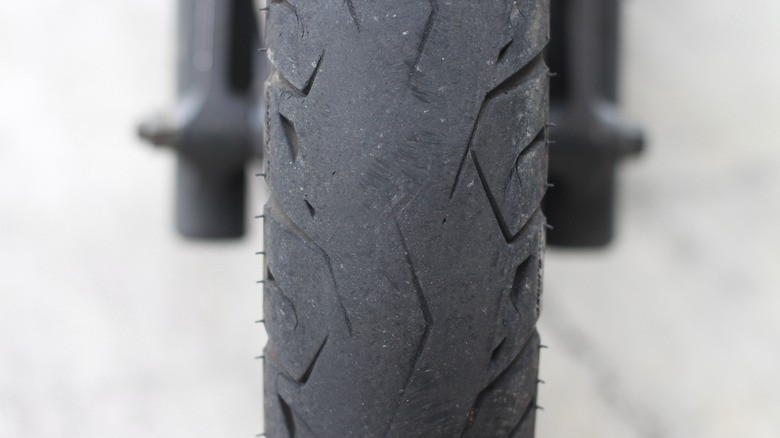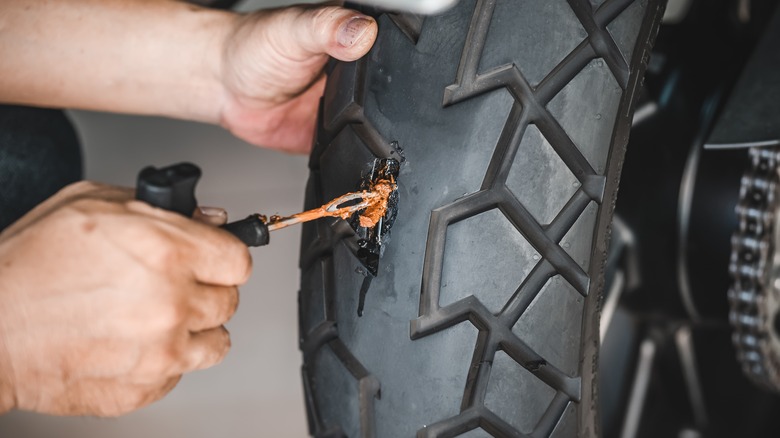5 Common Signs Your Motorcycle Tire Needs To Be Balanced
Tires are two of the most important components of a motorcycle. This may sound like an incredibly obvious statement, one that doesn't need an explanation, but your bike's tires are actually made up of a surprisingly complex system of checks and balances. After all, a tire isn't just a tube of nondescript rubber wrapped around your motorcycle's wheels; it's a carefully crafted, expertly balanced component designed to carry the vehicle across the road with speed, safety, and comfort.
As with any complex system, it only takes a little hiccup to throw everything else completely out of whack. A small scuff here or a little jostle there, and suddenly you're driving around on an oval instead of a perfect circle. Much like the alignment and rotation of the wheels, your tires need to be perfectly balanced to handle the weight of the motorcycle and the impact of the road. While it is possible to drive with unbalanced tires in the literal sense, it's neither safe nor comfortable. If you're worried about driving around with unbalanced tires on your motorcycle, there are a few signs you can look out for that might warrant further investigation, either from you or a professional mechanic.
If you experience bumpy, uncomfortable riding
The first, most prominent symptom of unbalanced tires is a noticeable increase in bumpy, uncomfortable riding. Tires are weighted just so in order to carry the motorcycle and absorb the impact and wear of the road at the same time. If your tire is lighter or heavier in one spot than in the rest of it, that means your motorcycle will move across the ground more softly or heavily every time that part of the tire makes contact with the road.
With this imbalance will come more intense feedback from the road, which means a greater frequency of sudden bumps and uncomfortable vibrations. All of this shimmying and shaking is passed on to you through the seat and handlebars. Imagine being subjected to a constant, bone-shaking vibration as though you were driving along a rumble strip, even if the road you're on is perfectly flat. That's what trying to drive with unbalanced tires is like.
It is worth noting that other potential problems could cause similar kinds of rumbling in a motorcycle, such as malfunctions in the wheels or suspension. If the vibration is nearly constant, and at a specific speed, though, tire balancing is the most likely suspect.
You see reduced control over the motorcycle
In addition to being generally uncomfortable, the intense vibrations caused by unbalanced motorcycle tires can have dangerous knock-on effects on the rest of the motorcycle and your riding. For one thing, the constant vibration makes it much more difficult to safely control your motorcycle. Even if the shaking going up through the body and handlebars wasn't making your fingers go numb, the minute bouncing and sinking of unbalanced tires make it much more difficult to keep the bike rolling in a straight, clean line. It only takes a bit of shimmying on the tire to nudge you off course, and while you can address it yourself, you're going to be doing course-correcting nearly constantly as you drive. That's a distraction you definitely don't need while operating a motorcycle.
In an additional concern, the vibrations from the tires and the road can start to adversely affect the rest of the motorcycle's integrity. The constant force being exerted on the bottom of the bike can cause the fasteners in the wheels and suspension to loosen slightly. While they probably won't come flying off, even a slight loosening in the wheels can have a noticeable effect on the bike's handling, as if the impact on your handling wasn't already bad enough from the vibrations.
You have heavier fuel consumption
When your motorcycle tires are unbalanced, particularly if they're too heavy in spots, that can cause them to drag along the ground. Tire dragging, even if it's only for a moment, is absolute murder on your motorcycle's engine. When your tires drag like that, your engine needs to work harder to keep them rolling. Have you ever tried to pedal a bicycle with flat tires, and found it to be incredibly exhausting and inefficient? It's the same experience for your poor engine.
The most obvious effect is a worsening of fuel economy. Forcing your engine to exert itself like that necessitates a greater degree of fuel consumption to compensate. Even if you're driving around on the same roads you always do, doing so with unbalanced tires burns up noticeably more fuel than it normally would, which means more frequent trips to the gas station to fill up. Pushing the engine beyond its ideal limits also isn't great for its general longevity; don't be surprised if the engine starts to show its age earlier than you may have expected if you've been rolling around on unbalanced tires.
Strange, uneven tire tread
One of the most obvious signs of unbalanced tires, aside from the aforementioned vibrations, is uneven, unusual wearing on the tire's treads. When a tire is perfectly balanced, all of its treads should be perfectly straight and uniform because the vehicle is enduring the road as it's supposed to be. However, when your tires are unbalanced, the subtle bucks and bounces that come from differently weighted sections hitting the road can cause the various surfaces of the tire to wear in unusual patterns.
Tires always wear out eventually, of course, but they're not supposed to wear out like this. Unbalanced tires may show a strange scalloped or cupped pattern of wearing along the sides, as well as bulges on the sidewall. Calling it a "pattern" is generous, because this wear will usually be scattered around at random along the surface of the tire. Besides being kind of weird-looking, that kind of uneven patterning on a tire can make it noticeably worse at safely handling various kinds of terrain.
Heavier, faster tire wearing
Not only can a tire imbalance cause strange wearing patterns along its surface, but any and all wearing that the tire experiences, including the regular day-to-day wear, can be significantly exacerbated. The constant vibrations, combined with the weight of the motorcycle on top and the force of being dragged along the road, will wear your tires down to dangerous levels in record time. Tires already have enough stress in regular use as it is, so this doesn't help.
If you notice that your tires are either becoming visibly worn down or are otherwise performing worse in general, even if you didn't buy them that long ago, a tire imbalance is a potential cause. If the imbalance is bad enough, then the wearing could also occur in random places, much like the unusual wearing patterns we mentioned before. A tire that's been uniformly worn out is already pretty unsafe to drive on, but one that's been covered in patches of visible damage is an absolute non-starter.
